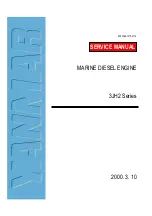
i06832774
Engine
Stopping
Stopping
the
Engine
NOTICE
Stopping the engine immediately after it has been
working under load, can result in overheating and ac-
celerated wear of the engine components.
Avoid accelerating the engine prior to shutting it
down.
Avoiding hot engine shutdowns will maximize turbo-
charger shaft and bearing life.
Note:
Individual applications will have different
control systems. Ensure that the shutoff procedures
are understood. Use the following general guidelines
to stop the engine.
1.
Remove the load from the engine. Reduce the
engine speed (rpm) to low idle. Allow the engine to
idle for 5 minutes to cool the engine.
2.
Stop the engine after the cool down period
according to the shutoff system on the engine.
Turn the ignition key switch to the OFF position. If
necessary, refer to the instructions that are
provided by the OEM.
NOTICE
Before any service or repairs are performed, ensure
that the power supply to the engine is disconnected.
i07764840
Emergency
Stopping
NOTICE
Emergency shutoff controls are for EMERGENCY
use ONLY. DO NOT use emergency shutoff devices
or controls for normal stopping procedure.
The Original Equipment Manufacturer (OEM) may
have equipped the application with an emergency
stop button. For more information about the
emergency stop button, refer to the OEM information.
Ensure that any components for the external system
that support the engine operation are secured after
the engine is stopped.
i02330274
After
Stopping
Engine
Note:
Before
you
check
the
engine
oil,
do
not
operate
the
engine
for
at
least
10
minutes
in
order
to
allow
the
engine
oil
to
return
to
the
oil
pan.
Contact with high pressure fuel may cause fluid
penetration and burn hazards. High pressure fuel
spray may cause a fire hazard. Failure to follow
these inspection, maintenance and service in-
structions may cause personal injury or death.
• After the engine has stopped, you must wait for 60
seconds in order to allow the fuel pressure to be
purged from the high pressure fuel lines before
any service or repair is performed on the engine
fuel lines. If necessary, perform minor
adjustments. Repair any leaks from the low
pressure fuel system and from the cooling,
lubrication or air systems. Replace any high
pressure fuel line that has leaked. Refer to
Disassembly and assembly Manual, “Fuel
Injection Lines - Install”.
• Check the crankcase oil level. Maintain the oil
level between the
“
MIN
”
mark and the
“
MAX
”
mark
on the engine oil level gauge.
• If the engine is equipped with a service hour
meter, note the reading. Perform the maintenance
that is in the Operation and Maintenance Manual,
“Maintenance Interval Schedule”.
• Fill the fuel tank in order to help prevent
accumulation of moisture in the fuel. Do not overfill
the fuel tank.
NOTICE
Only use antifreeze/coolant mixtures recommended
in the Coolant Specifications that are in the Operation
and Maintenance Manual. Failure to do so can cause
engine damage.
Pressurized System: Hot coolant can cause seri-
ous burns. To open the cooling system filler cap,
stop the engine and wait until the cooling system
components are cool. Loosen the cooling system
pressure cap slowly in order to relieve the
pressure.
• Allow the engine to cool. Check the coolant level.
SEBU8172-04
45
















































